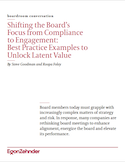Board members today must grapple with increasingly complex matters of strategy and risk. In response, many companies are rethinking board meetings to enhance alignment, energize the board and elevate its performance.
In a conversation with a board chair and a CEO following a successful board search, we asked if their recently completed board review had surfaced any issues regarding the chair of the governance committee. The board chair was a bit surprised and asked what prompted our question. We then discussed what “good” looked like for a governance committee chair, and compared that benchmark of behaviors with the experience and inclinations of the incumbent. It quickly became evident that the board review they had undergone had relied too heavily on a simple questionnaire, which, to make matters worse, was analyzed in a cursory way by an outside firm. This “check the box” compliance-oriented exercise rarely leads to a meaningful improvement of board effectiveness and engagement.
Given that today’s investors scrutinize a company’s board of directors as closely as its financial results, boards increasingly are seeking more thorough board reviews to help ensure that their team interactions and processes are aligned. A proper board effectiveness review goes beyond the standard questionnaire and is centered on individual behaviors and team dynamics and interactions.
Each board has its own set of issues, depending on the history, structure and personalities involved. Even so, in the more than 550 board effectiveness reviews that Egon Zehnder has conducted, we have seen a common challenge emerge: The ongoing struggle to stay focused on strategy and not get bogged down with administrative and procedural matters. And it is a struggle: As more and more topics, from digitalization to diversity, are added to the board’s agenda, it becomes increasingly difficult even to track the various issues that directors must monitor, let alone for directors to step back and consider those issues in a larger context. The reality is that the board’s processes and information flow can unwittingly be at cross purposes with a strategic perspective. These are the sorts of derailers that a thorough board effectiveness review can uncover, while also putting in place mechanisms for ongoing, rather than periodic, feedback.
The board meeting today: Documentation and the agenda
Consider how the typical two-day board meeting unfolds. Approximately two weeks before the meeting, members receive the agenda and supporting materials to review. In the hard-copy era, the thickness of the board book was limited by the size of the FedEx box it was shipped in. Today, however, most companies use digital board books accessed through tablets. These applications are rightly heralded for their convenience, but they also remove any physical constraints on the amount of material distributed to the board. As a result, we have found that board members are inundated with reports, presentation decks and miscellaneous analyses on everything from investor relations to cybersecurity to safety compliance. Board members are sometimes surprised to learn that they contribute to this problem by their own requests for additional information. This is why some governance experts have sounded an alarm on a “boardroom information crisis”; it becomes harder and harder for even the most diligent board members to absorb, digest and reflect on all the material they are given. Managing the deluge of data crowds out the time needed to ask important questions. The board book material, instead of supporting the agenda, can detract from the agenda items truly needing attention.
We see this when we examine how typical board meetings unfold. The first day is frequently devoted to committee meetings. The board then gathers for dinner and then convenes the next day to work through the board agenda. At some point in the afternoon the meeting adjourns and everyone departs.
On its face, there is nothing objectionable about this structure, but a better approach is to recognize that significant amounts of committee work today can be conducted by teleconference, allowing the committee to work through many issues before the board meeting. This is not to say that the entire committee agenda can be dealt by phone, but that there are many ways of being more effective in filtering what requires the attention of the full board.
The board meeting reconsidered: Deep dives and discussion
What would a board meeting look like if the meeting were designed to maximize meaningful strategic discussion? Two to three weeks before the board meeting, a much thinner board book would be distributed. It would start with a one- or two-page letter from the CEO and board chair. The CEO would summarize the state of the company and frame key issues, and the chairman would outline the agenda for the upcoming board meeting, The agenda would include more time for discussion and debate, and be centered on a select number of strategic issues, sizable operating issues and major risk items. The supporting material in the board book would provide background on those topics. Of course, other administrative matters will still need to be discussed, but the majority of time would center on priorities that could unlock value.
For example, instead of reviewing in detail an investor relations presentation that has already been vetted and approved by the CFO and CEO, the board might be asked to consider the key issues and concerns that shareholders and analysts have most recently surfaced and flagged. Instead of the company’s latest 100-page sustainability report, the quarterly board book might include a summary of metrics and performance indicators while reserving a full-board “deep dive” discussion for once a year.
Committee chairs would conduct many agenda items by conference call. When the directors arrive on the first day, instead of breaking into committees, the entire board would meet for a detailed briefing by the CEO on the most pressing matters. A working dinner would follow, during which directors would discuss specific topics and could begin to identify points of agreement and divergence. The next day, the board would meet for a frank discussion to stretch and challenge assumptions and to work toward decisions. While some of the board meeting will have to be devoted to procedural matters, the board’s major focus is kept on a higher, strategic plane. The board chair of one of the world’s largest public companies recently shared with us his realization that when he was CEO and chairman of a prior company, he didn’t devote sufficient time to the board agenda. Only later did he realize that getting the agenda right has a sizable impact on board performance.

In an earlier day, it was sufficient for boards to monitor management’s performance, approve major decisions and ensure conformity with a much smaller set of regulations. But in today’s much more complex environment, it is not enough for boards to be stewards; they, like management, need to create value. The board does this when it focuses on its role as advisor and resource to management, rather than its mere overseer. Rethinking board meetings, considering team dynamics and providing open feedback to board members can align the board with this goal. That, in turn, will energize the board and elevate its performance.

Shifting the Board’s Focus from Compliance to Engagement: Best Practice Examples to Unlock Latent Value
Download as PDF






